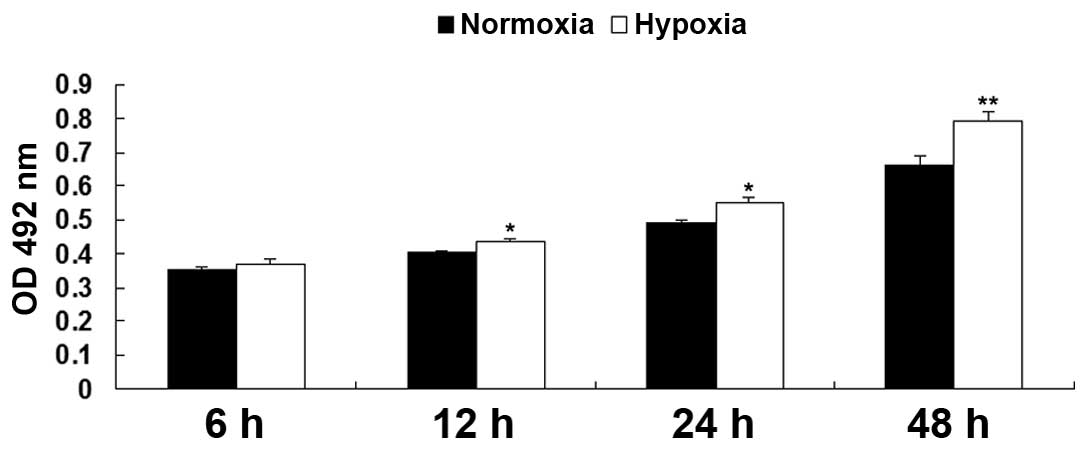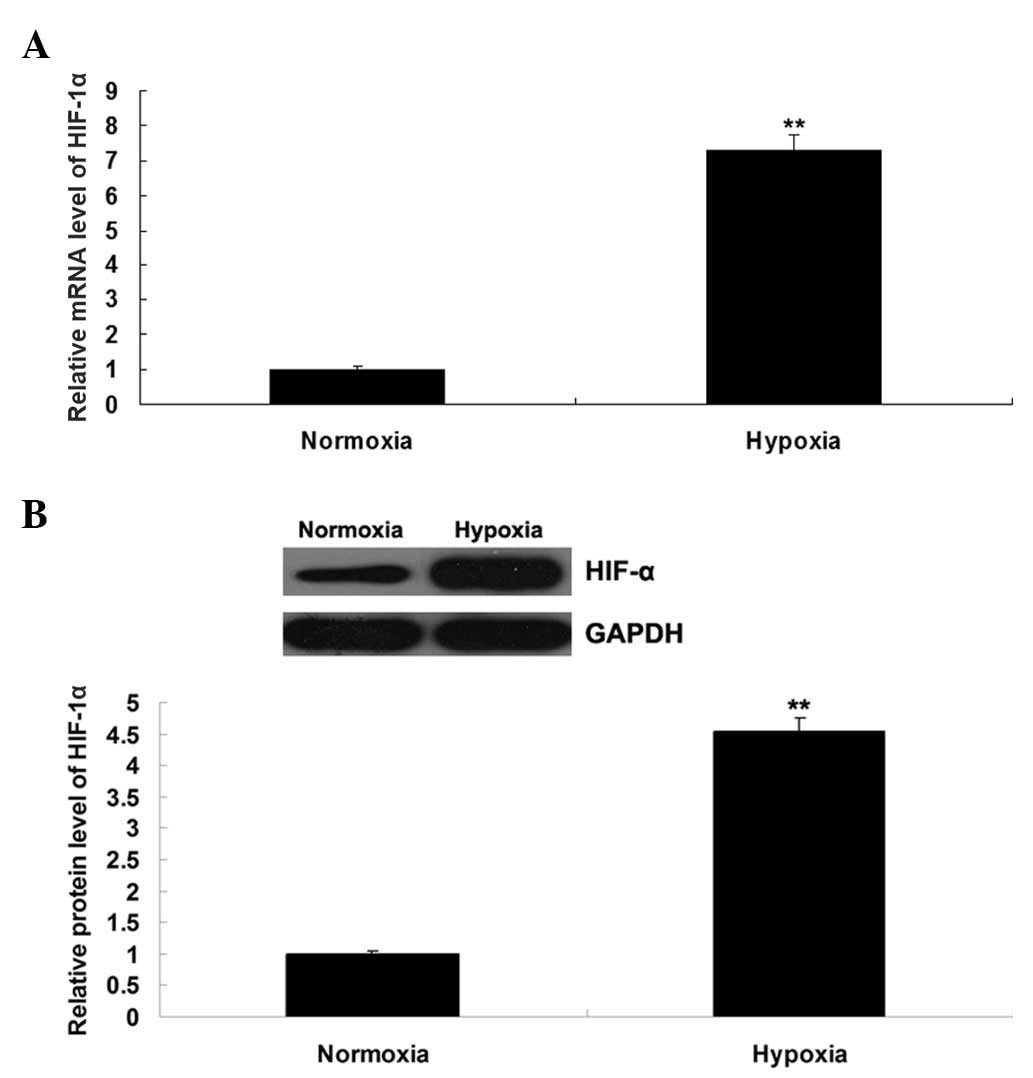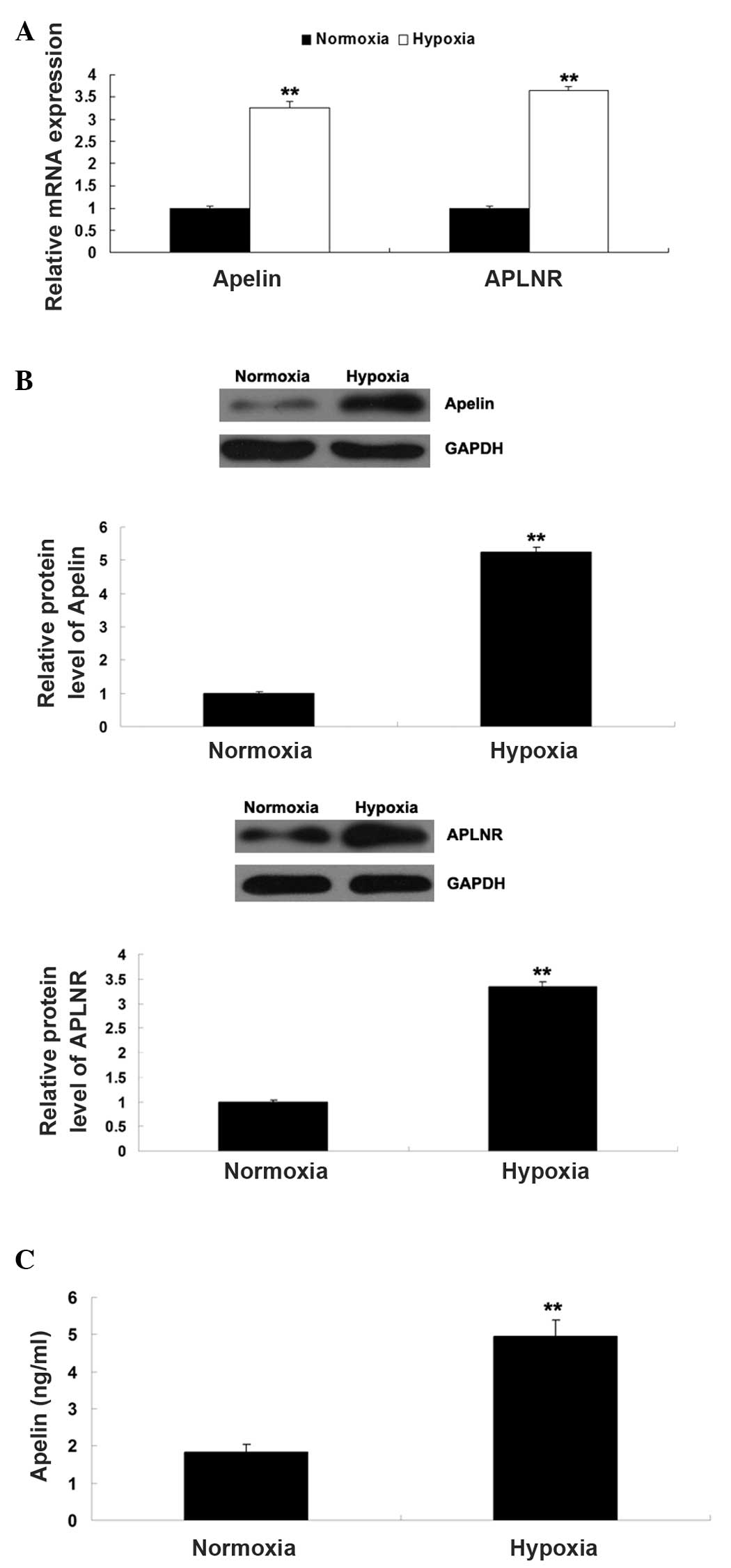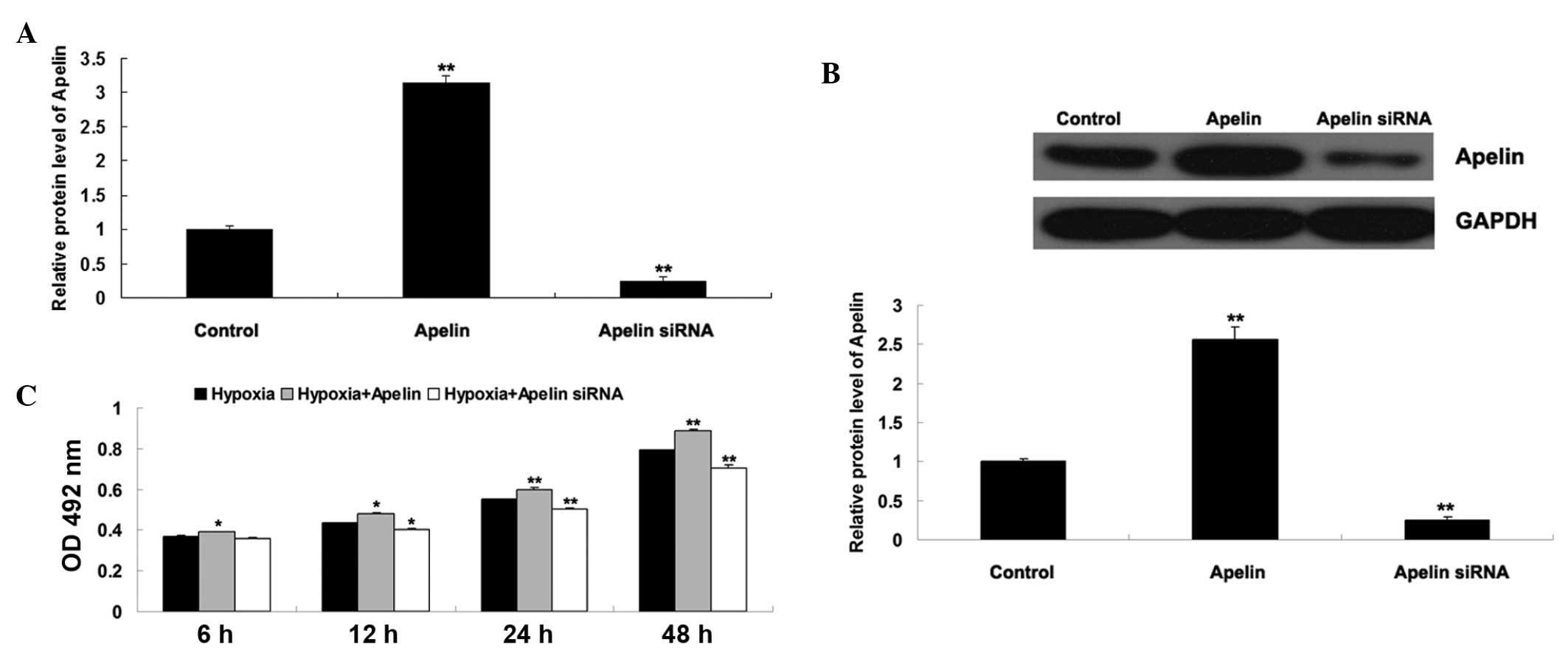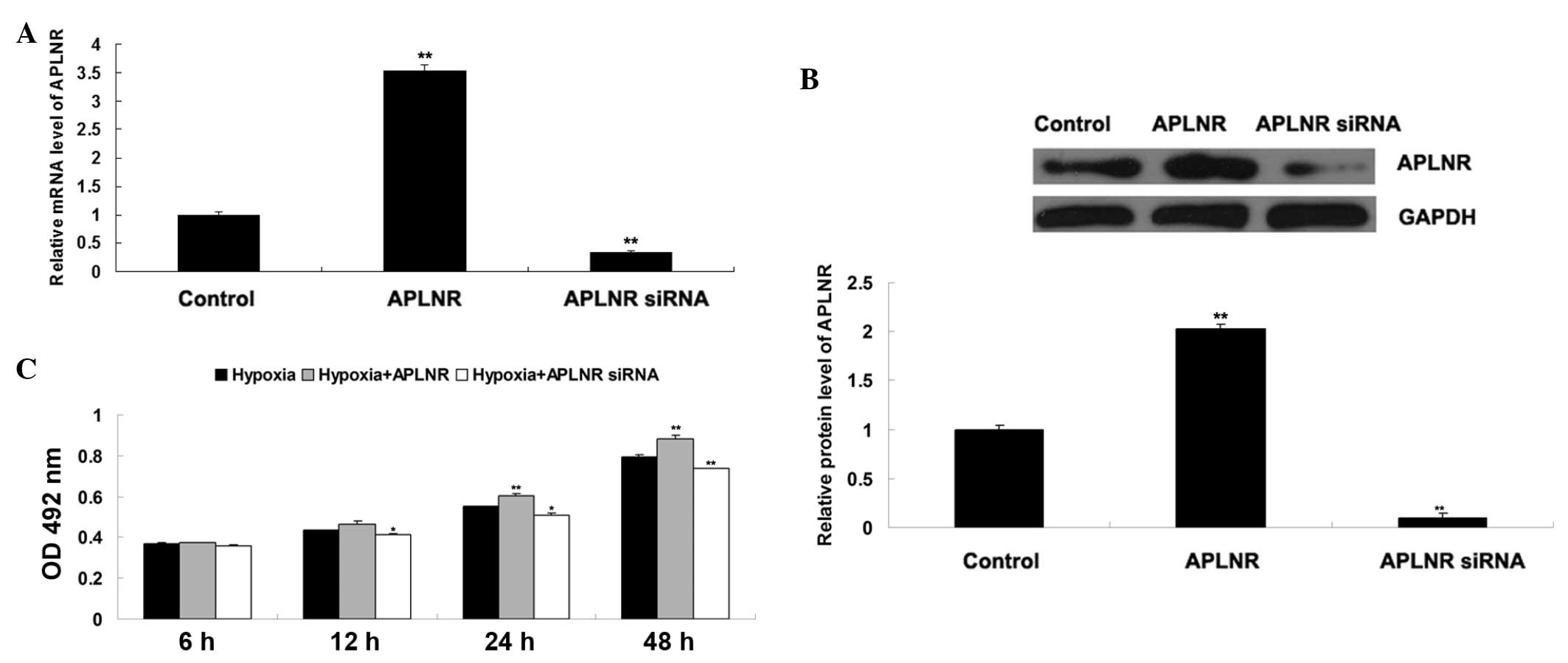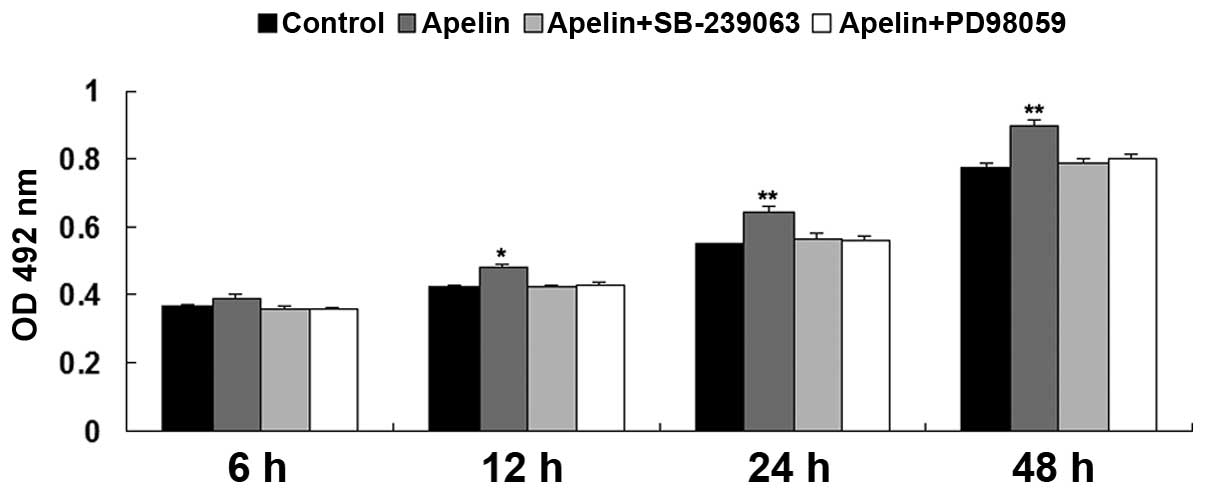Hypoxia induces the proliferation of endothelial progenitor cells via upregulation of Apelin/APLNR/MAPK signaling
- Authors:
- Published online on: December 17, 2015 https://doi.org/10.3892/mmr.2015.4691
- Pages: 1801-1806
Abstract
Introduction
Endothelial progenitor cells (EPCs) can differentiate into endothelial cells (ECs) and are important in angiogenesis (1). It has been demonstrated that oxidative stress-induced endothelial dysfunction can cause ischemia/reperfusion injury, and the proliferation and differentiation of EPCs are essential for the treatment of this type of injury. Hypoxia has been demonstrated to mobilize EPCs from the bone marrow into the peripheral blood (2), and induce ECs to secret chemokines for the recruitment and migration of EPCs to hypoxic tissues (3). In addition, hypoxia can induce the expression of hypoxia-inducible factor-1α (HIF-1α), an important transcriptional factor that is involved in the proliferation and differentiation of EPCs (4).
Apelin is an endogenous ligand for the G protein-coupled receptor, APLNR (5). It has been suggested that Apelin/APLNR signaling can be activated by HIF-1α in hypoxia neonatal cardiomyocytes (6). In addition, downregulated serum levels of Apelin are associated with EPC mobilization induced by acute myocardial infarction (7) and Apelin deficiency impairs EPC sprouting in ischemia-reperfusion injury (8). These findings suggest that Apelin may be involved in the regulation of EPC mobilization and sprouting. However, whether the Apelin/APLNR signaling is involved in hypoxia-induced EPC proliferation has not been investigated previously.
The mitogen-activated protein kinase (MAPK) signaling pathway is important in the regulation of cellular survival, proliferation, differentiation and migration (9). It has been demonstrated that the MAPK signaling pathway is involved in the regulation of EPC proliferation, for example, the effect of granulocyte macrophage colony-stimulating factor on the modulation of EPC proliferation is mediated by the MAPK signaling pathway (10). Our previous study revealed that Apelin/APLNR signaling promotes hypoxia-induced proliferation of EPCs via phosphoinositide 3 kinase/Akt signaling (11). However, whether Apelin/APLNR signaling regulates EPC proliferation via MAPK signaling remains to be elucidated
The aim of the present study was to determine the underlying molecular mechanisms by which Apelin/APLNR signaling regulates the hypoxia-induced proliferation of EPCs.
Materials and methods
Cell isolation and culture
EPCs were isolated from the umbilical cord at the Second Xiangya Hospital of Central South University in September 2012. Briefly, umbilical cord tissue sample was diluted with Dulbecco's phosphate-buffered saline at a ratio of 1:1 and overlaid onto 1.077 g/ml Ficoll-Paque™ Premium (GE Healthcare Bio-Sciences, Pittsburgh, PA, USA) prior to centrifugation for 30 min at 400 × g. The monocytes were collected and seeded into tissue culture plates coated with fibronectin (EMD Millipore, Billerica, MA, USA), and cultured in endothelial growth medium (EGM)-2 (Thermo Fisher Scientific, Waltham, MA, USA) supplemented with 20% fetal bovine serum (FBS; Tianhang Biological Technology Co., Ltd., Hangzhou, China) at 37°C in a humidified incubator containing 5% CO2. The culture media was changed every two days until EPC colonies appeared. Typical colonies appear between days 5 and 10, and were passaged at sub-confluence. The present study was approved by the ethics committee of the Second Xiangya Hospital of Central South University (Changsha, China).
Hypoxia treatment of the EPCs
Prior to hypoxia treatment, the EPCs (5×105) were cultured in serum-free EGM-2 at 37°C, 5% CO2 for 12 h. Subsequently, the EPCs were cultured in EGM-2 containing 20% FBS at 37, 1% O2/94% N2/5% CO2 for 6, 12, 24 and 48 h.
Cell proliferation assay
An MTT assay was performed to determine the cell proliferation. In brief, 10 mg/ml MTT (Thermo Fisher Scientific) was added to the medium following culture. Following incubation for 4 h, the reaction was terminated by removal of the supernatant and the addition of 100 µl dimethyl sulfoxide (DMSO; Thermo Fisher Scientific) to dissolve the formazan product. After 30 min, the optical density (OD) of each well was measured at 570 nm using a microplate reader (ELx808; Bio-Tek Instruments, City, ST, USA).
Reverse transcription-quantitative polymerase chain reaction (RT-qPCR) analysis
TRIzol reagent (Life Technologies, Carlsbad, CA, USA) was used to extract the total RNA from the EPCs, according to the manufacturer's instructions. The total RNA was reverse transcribed into cDNA using a RevertAid First-Strand cDNA Synthesis kit (Thermo Fisher Scientific), according to the manufacturer's instructions. The mRNA expression level was determined using iQTM SYBR Green Supermix (Bio-Rad Laboratories, Inc., Hercules, CA, USA), according to the manufacture's instructions. The reaction mixture contained 1 µl cDNA solution, 10 µl PCR master mix, 2 µl primers (Sangon Biotech Co., Ltd., Shanghai, China), and 7 µl H2O were mixed to obtain a final reaction volume of 20 µl. The qPCR was conducted using an ABI7500 PCR system (Invitrogen; Thermo Fisher Scientific, Inc.) with the following reaction conditions: Pre-degeneration at 95°C for 1 min, followed by 40 cycles of 95°C for 15 sec, 60°C for 15 sec and 72°C for 1 min. The specific primer pairs used were as follows: HIF-1α, sense 5′-GAACGTCGAAAAGAAAAGTCTCG-3′ and antisense 5′-CCTTATCAAGATGCGAACTCACA-3′; Apelin, sense 5′-GTCTCCTCCATAGATTGGTCTGC-3′ and antisense 5′-GGAATCATCCAAACTACAGCCAG-3′; APLNR, sense 5′-CTCTGGACCGTGTTTCGGAG-3′ and antisense 5′-GGTACGTGTAGGTAGCCCACA-3′; and GAPDH (as an inter nal reference) sense 5′-GGAGCGAGATCCCTCCAAAAT-3′ and antisense 5′-GGCTGTTGTCATACTTCTCATGG-3′. Independent experiments were repeated three times. The relative expression levels of mRNA were analyzed using the 2−∆∆Ct method (12).
Transfection
Transfection of the cells was performed using Lipofectamine 2000 (Invitrogen; Thermo Fisher Scientific, Inc.), according to the manufacturer's instructions. For functional analysis, the EPCs were transfected with either an Apelin plasmid, Apelin-specific siRNA, an APLNR plasmid or APLNR-specific siRNA (Nlunbio, Changsha, China).
Western blot analysis
The cells were solubilized in cold radioimmunoprecipitation assay lysis buffer. The proteins were quantified using a Bicinchoninic Acid Protein Assay kit (Thermo Fisher Scientific, Inc.), according to the manufacturer's instructions. The resulting proteins (50 µg) were separated with 12% SDS-PAGE (Beyotime Institute of Biotechnology, Shanghai, China) and transferred onto a polyvinylidene difluoride (PVDF) membrane (Thermo Fisher Scientific), which was then incubated with Tris-buffered saline with 1% Tween 20 (Thermo Fisher Scientific) containing 5% skimmed milk at 4°C for overnight. Following incubation, the PVDF membrane was incubated with mouse anti-HIF-α, mouse anti-Apelin, mouse anti-APLNR and mouse anti-GAPDH primary antibodies (Abcam, Cambridge, UK), respectively, at room temperature for 3 h. Following washing with PBS with 1% Tween 20 (PBST; Thermo Fisher Scientific) three times, the PVDF membrane was incubated with rabbit anti-mouse secondary antibody (Abcam) at room temperature for 1 h. Following washing with PBST three times, an ECL kit (Pierce Chemical, Rockford, IL, USA) was used to perform chemiluminescent detection. The relative expression of proteins were determined using Image-Pro plus software 6.0, presented as the density ratio, compared with GAPDH.
Statistical analysis
All data are expressed as the mean ± standard deviation of three independent experiments. Statistical analyses of differences were performed using one-way analysis of variance with SPSS 17 software (SPSS, Inc., Chicago, IL, USA). P<0.05 was considered to indicate a statistically significant difference.
Results
Hypoxia promotes EPC proliferation
The proliferation rates of the EPCs were examined under hypoxia and normoxia using an MTT assay. As shown in Fig. 1, following culture in hypoxia for 6, 12, 24, and 48 h, the relative proliferation rates of the EPCs were notably upregulated, compared with the EPCs cultured in normoxia, indicating that hypoxia promoted EPC proliferation.
Hypoxia induces the upregulation of HIF-1α and Apelin/APLNR signaling
The expression level of HIF-1α was further determined by performing RT-qPCR and western blot assays. As shown in Fig. 2A and B, the mRNA and protein expression levels of HIF-1α were notably upregulated in the EPCs cultured under hypoxia, compared with those cultured in normoxia. As Apelin/APLNR signaling has been found to be regulated by HIF-1α, the present study further determined the expression levels of Apelin and APLNR in EPCs cultured under hypoxia or normoxia, respectively. As shown in Fig. 3A and B, the mRNA and protein expression levels of Apelin and APLNR were significantly upregulated in the EPCs cultured under hypoxia, compared with those cultured in normoxia. In addition, the secretion of Apelin was determined using ELISA. As shown in Fig. 3C, the secretion level of Apelin was also increased in the EPCs cultured under hypoxia, compared with those cultured in normoxia. Taken together, these findings suggested that hypoxia induced the upregulation of HIF-1α and its downstream Apelin/APLNR signaling in the EPCs.
Role of Apelin/APLNR signaling in EPC proliferation
The role of Apelin/APLNR signaling was further investigated in the proliferation of EPCs cultured under hypoxia or normoxia, respectively. The EPCs were initially transfected either with an Apelin plasmid or siRNA, in order to upregulate or down-regulate Apelin/APLNR signaling, respectively. As shown in Fig. 4A and B, the mRNA and protein expression levels of Apelin increased in the EPCs transfected with the Apelin plasmid, and reduced in the EPCs transfected with the Apelin siRNA. The present study subsequently determined the proliferation of EPCs cultured under hypoxia or normoxia using an MTT assay. As shown in Fig. 4C, the proliferation of the EPCs in normoxia + Apelin group was higher than that in the normoxia group, suggesting that the upregulation of Apelin enhanced EPC proliferation. In addition, the proliferation of the EPCs in the hypoxia + Apelin siRNA group was lower than that in the hypoxia group, suggesting that the inhibition of Apelin suppressed hypoxia-induced EPC proliferation.
To further confirm the hypothesis that Apelin/APLNR signaling is involved in EPC proliferation, the present study transfected EPCs with either an APLNR plasmid or siRNA. As shown in Fig. 5A and 5B, the mRNA and protein expression levels of APLNR were increased in the EPCs transfected with the APLNR plasmid, but reduced in the EPCs transfected with APLNR siRNA. The proliferation of EPCs cultured under hypoxia or normoxia was then determined using an MTT assay. As shown in Fig. 5C, the proliferation of EPCs in the normoxia + APLNR group was higher than that in the normoxia group, suggesting that upregulation of APLNR enhanced EPC proliferation. In addition, the proliferation of EPCs in the hypoxia + APLNR siRNA group was lower than that in the hypoxia group, suggesting that the inhibition of APLNR suppressed hypoxia-induced EPC proliferation. Taken together, these findings suggested that Apelin/APLNR signaling is a key regulator of hypoxia-induced EPC proliferation.
MAPK signaling pathway is a downstream effecter of Apelin/APLNR signaling during hypoxia-induced EPC proliferation
As the MAPK signaling pathway has been suggested to be involved in hypoxia-induced EPC proliferation, the present study further investigated whether the MAPK signaling pathway is a downstream effecter of Apelin/APLNR signaling during hypoxia-induced EPC proliferation. The P38 MAPK inhibitor, SB-239063, or ERK MAPK inhibitor, PD98059, was used to treat EPCs, which had been transfected with the Apelin plasmid. A total of four groups of EPCs were cultured under hypoxia, as follows: Control group without any treatment, Apelin group, Apelin + SB-239063 group, and Apelin + PD98059 group. As shown in Fig. 6, the upregulation of Apelin promoted EPC proliferation under hypoxia, which was abrogated by pretreatment with SB-239063 or PD98059, respectively. These findings suggested that inhibition of MAPK signaling suppressed hypoxia-induced EPC proliferation. Taken together, it was suggested that MAPK pathway is a downstream effecter of Apelin/APLNR signaling during hypoxia-induced EPC proliferation.
Discussion
The Apelin/APLNR signaling pathway has been demonstrated to be closely associated with cardiovascular functions in the systemic circulation (13). In the present study, hypoxia-induced upregulation of HIF-α and Apelin/APLNR signaling was found to be involved in the proliferation of EPCs. In addition, the results suggested that MAPK signaling is involved in Apelin/APLNR-mediated EPC proliferation.
Hypoxia has been demonstrated to be involved in the regulation of cellular processes of EPCs (14). In the present study, hypoxia notably enhanced the proliferation of EPCs. Lee et al reported that hypoxia inhibits senescence of EPCs in aged humans (15). In addition, hypoxia/ischemia triggers EPCs to proceed from bone marrow into the peripheral blood, and EPCs can differentiate into ECs following migration into the site of hypoxia/ischemia in tissues (16). In addition, HIF-1α pis important in the regulation of angiogenesis. Overexpression of HIF-1α can promote the differentiation of EPCs into ECs, while inhibition of the expression of HIF-1α suppresses the differentiation of EPCs into ECs, as well as the expression of vascular endothelial growth factor (VEGF), VEGF receptor 2, eNOS, and the production of NO (4,17,18). The present study demonstrated that the expression level of HIF-α was notably upregulated in EPCs cultured under hypoxia.
Apelin/APLNR signaling is involved in various physiological and pathological functions in the cardiovascular system. Apelin/APLNR signaling promotes angiogenesis and improves cardiac functional recovery post-myocardial infarction (19). In addition, Lv et al observed that Apelin/APLNR signaling regulates the proliferation of vascular smooth muscle cells (20), and Kasai et al found that inhibition of Apelin/APLNR signaling inhibits the proliferation of ECs (21). In the present study, the expression levels of Apelin and APLNR were found to be increased in EPCs cultured under hypoxia. The Apelin/APLNR signaling is also involved in the mobilization of EPCs following acute myocardial infarction (7). The present study hypothesized that the increased expression of Apelin/APLNR is associated with the upregulation of HIF-α in hypoxia-treated EPCs, as the association between HIF-1α and Apelin/APLNR signaling has been reported in other cell types. Glassford et al demonstrated that HIF-1α regulated the expression of Apelin in hypoxia-treated adipocytes (22). Ronkainen et al found that the upregulation of Apelin was eliminated by HIF inhibitory PAS protein in cardiomyocytes cultured under hypoxia (23). These findings suggest that the Apelin/APLNR signaling is mediated by the HIF pathway in adipocytes and cardiomyocytes cultured under hypoxia. In addition, the present study further demonstrated that knockdown of Apelin/APLNR signaling significantly inhibited hypoxia-induced EPC proliferation. These findings are the first time, to the best of our knowledge, to suggest that Apelin/APLNR signaling is involved in regulating the proliferation of EPCs cultured under hypoxia.
The underlying mechanisms by which Apelin/APLNR signaling regulates hypoxia-induced EPCs proliferation requires further investigation. The present study demonstrated that inhibition of the p38 and ERK MAPK signaling pathways suppressed hypoxia-induced proliferation of EPCs transfected with an Apelin plasmid. Similar findings have been observed in other cell types. Apelin/APLNR suppresses the production and release of reactive oxygen species and promotes the expression of anti-oxidant enzymes via the MAPK signaling pathway in adipocytes (24). Yang et al revealed that Apelin/APLNR signaling protects the brain against ischemia/reperfusion injury via activation of the ERK MAPK signaling pathway (25). However, whether the MAPK signaling pathway is involved in Apelin/APLNR signaling-mediated EPC proliferation remains to be elucidated. The data of the present study suggested, for the first time that the p38 and ERK MAPK signaling pathway acts as a downstream effecter of Apelin/APLNR signaling during hypoxia-induced EPC proliferation.
In conclusion, the results of the present study suggested that hypoxia-induced upregulation of HIF-1α activates Apelin/APLNR signaling, which promotes the proliferation of EPCs via the downstream MAPK signaling pathway. These findings suggested that the Apelin/APLNR signaling may be applied as a therapeutic target for hypoxic/ischemic injury.
References
|
Endemann DH and Schiffrin EL: Endothelial dysfunction. J Am Soc Nephrol. 15:1983–1992. 2004. View Article : Google Scholar : PubMed/NCBI | |
|
Schröder K, Kohnen A, Aicher A, Liehn EA, Büchse T, Stein S, Weber C, Dimmeler S and Brandes RP: NADPH oxidase Nox2 is required for hypoxia-induced mobilization of endothelial progenitor cells. Circ Res. 105:537–544. 2009. View Article : Google Scholar : PubMed/NCBI | |
|
Simons D, Grieb G, Hristov M, Pallua N, Weber C, Bernhagen J and Steffens G: Hypoxia-induced endothelial secretion of macrophage migration inhibitory factor and role in endothelial progenitor cell recruitment. J Cell Mol Med. 15:668–678. 2011. View Article : Google Scholar | |
|
Jiang M, Wang CQ, Wang BY and Huang DJ: Inhibitory effect of siRNA targeting HIF-1alpha on differentiation of peripheral blood endothelial progenitor cells. Ai Zheng. 24:1293–1300. 2005.In Chinese. | |
|
Kleinz MJ and Baxter GF: Apelin reduces myocardial reperfusion injury independently of PI3K/Akt and P70S6 kinase. Regul Pept. 146:271–277. 2008. View Article : Google Scholar | |
|
Zhang Z, Yu B and Tao GZ: Apelin protects against cardiomyocyte apoptosis induced by glucose deprivation. Chin Med J (Engl). 122:2360–2365. 2009. | |
|
Ye J, Ni P, Kang L and Xu B: Apelin and vascular endothelial growth factor are associated with mobilization of endothelial progenitor cells after acute myocardial infarction. J Biomed Res. 26:400–409. 2012. View Article : Google Scholar | |
|
Wang W, McKinnie SM, Patel VB, Haddad G, Wang Z, Zhabyeyev P, Das SK, Basu R, McLean B, Kandalam V, et al: Loss of Apelin exacerbates myocardial infarction adverse remodeling and ischemia-reperfusion injury: Therapeutic potential of synthetic Apelin analogues. J Am Heart Assoc. 2:e0002492013. View Article : Google Scholar : PubMed/NCBI | |
|
Kyriakis JM and Avruch J: Mammalian MAPK signal transduction pathways activated by stress and inflammation: A 10-year update. Physiol Rev. 92:689–737. 2012. View Article : Google Scholar : PubMed/NCBI | |
|
Qiu C, Xie Q, Zhang D, Chen Q, Hu J and Xu L: GM-CSF induces cyclin D1 expression and proliferation of endothelial progenitor cells via PI3K and MAPK signaling. Cell Physiol Biochem. 33:784–795. 2014. View Article : Google Scholar : PubMed/NCBI | |
|
Zhang J, Liu Q, Hu X, Fang Z, Huang F, Tang L and Zhou S: Apelin/APJ signaling promotes hypoxia-induced proliferation of endothelial progenitor cells via phosphoinositide-3 kinase/Akt signaling. Mol Med Rep. 12:3829–3834. 2015.PubMed/NCBI | |
|
Zhong Y, Lin Y, Shen S, Zhou Y, Mao F, Guan J and Sun Q: Expression of ALDH1 in breast invasive ductal carcinoma: An independent predictor of early tumor relapse. Cancer Cell Int. 13:602013. View Article : Google Scholar : PubMed/NCBI | |
|
O'Carroll AM, Lolait SJ, Harris LE and Pope GR: The Apelin receptor APJ: Journey from an orphan to a multifaceted regulator of homeostasis. J Endocrinol. 219:R13–R35. 2013. View Article : Google Scholar : PubMed/NCBI | |
|
Dai T, Zheng H and Fu GS: Hypoxia confers protection against apoptosis via the PI3K/Akt pathway in endothelial progenitor cells. Acta Pharmacol Sin. 29:1425–1431. 2008. View Article : Google Scholar : PubMed/NCBI | |
|
Lee SH, Lee JH, Yoo SY, Hur J, Kim HS and Kwon SM: Hypoxia inhibits cellular senescence to restore the therapeutic potential of old human endothelial progenitor cells via the hypoxia-inducible factor-1alpha-TWIST-p21 axis. Arterioscler Thromb Vasc Biol. 33:2407–2414. 2013. View Article : Google Scholar : PubMed/NCBI | |
|
Machalińska A: The role of circulating endothelial progenitor cells in the development of vascular retinal diseases. Klin Oczna. 115:158–162. 2013.In Polish. | |
|
Jiang M, Wang B, Wang C, He B, Fan H, Guo TB, Shao Q, Gao L and Liu Y: Inhibition of hypoxia-inducible factor-1alpha and endothelial progenitor cell differentiation by adenoviral transfer of small interfering RNA in vitro. J Vasc Res. 43:511–521. 2006. View Article : Google Scholar : PubMed/NCBI | |
|
Jiang M, Wang CQ, Wang BY, He B, Shao Q and Huang DJ: Overexpression of hypoxia inducible factor-1alpha (HIF-1alpha) promotes the differentiation of endothelial progenitor cell ex vivo. Zhongguo Shi Yan Xue Ye Xue Za Zhi. 14:565–570. 2006.In Chinese. PubMed/NCBI | |
|
Li L, Zeng H and Chen JX: Apelin-13 increases myocardial progenitor cells and improves repair postmyocardial infarction. Am J Physiol Heart Circ Physiol. 303:H605–H618. 2012. View Article : Google Scholar : PubMed/NCBI | |
|
Lv D, Li H and Chen L: Apelin and APJ, a novel critical factor and therapeutic target for atherosclerosis. Acta Biochim Biophys Sin (Shanghai). 45:527–533. 2013. View Article : Google Scholar | |
|
Kasai A, Ishimaru Y, Higashino K, Kobayashi K, Yamamuro A, Yoshioka Y and Maeda S: Inhibition of Apelin expression switches endothelial cells from proliferative to mature state in pathological retinal angiogenesis. Angiogenesis. 16:723–734. 2013. View Article : Google Scholar : PubMed/NCBI | |
|
Glassford AJ, Yue P, Sheikh AY, Chun HJ, Zarafshar S, Chan DA, Reaven GM, Quertermous T and Tsao PS: HIF-1 regulates hypoxia- and insulin-induced expression of Apelin in adipocytes. Am J Physiol Endocrinol Metab. 293:E1590–E1596. 2007. View Article : Google Scholar : PubMed/NCBI | |
|
Ronkainen VP, Ronkainen JJ, Hänninen SL, Leskinen H, Ruas JL, Pereira T, Poellinger L, Vuolteenaho O and Tavi P: Hypoxia inducible factor regulates the cardiac expression and secretion of Apelin. FASEB J. 21:1821–1830. 2007. View Article : Google Scholar : PubMed/NCBI | |
|
Than A, Zhang X, Leow MK, Poh CL, Chong SK and Chen P: Apelin attenuates oxidative stress in human adipocytes. J Biol Chem. 289:3763–3774. 2014. View Article : Google Scholar : | |
|
Yang Y, Zhang X, Cui H, Zhang C, Zhu C and Li L: Apelin-13 protects the brain against ischemia/reperfusion injury through activating PI3K/Akt and ERK1/2 signaling pathways. Neurosci Lett. 568:44–49. 2014. View Article : Google Scholar : PubMed/NCBI |



